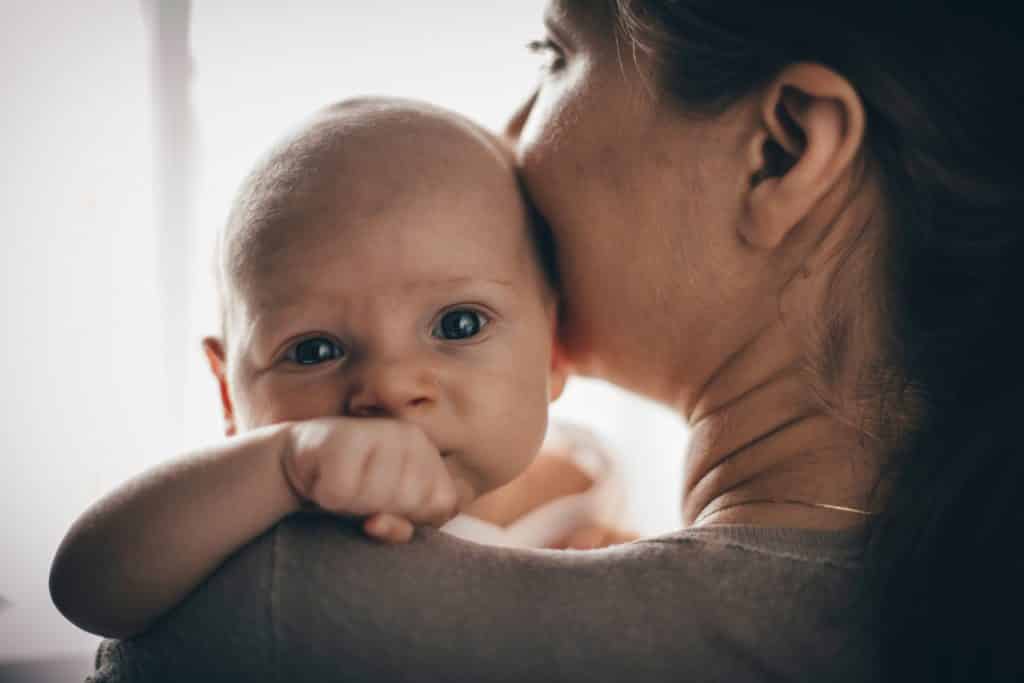
The first time you and your newborn lock eyes can be a joyous and overwhelming experience. That moment when they look at you with recognition in their eyes as they hear your voice for the first time in the outside world. But what can they see? Turns out not too much. Not for several weeks, anyway. Let’s explore your baby’s vision development and milestones to understand better how their vision works!
When Can Newborns See?
Your baby’s vision development will undergo many dramatic changes during the first year of life. But let us begin with those “fresh out of the womb” eyes. What can your brand-new newborn see?
Because your newborn’s retinas are still developing after birth, your newborn’s eyes are very sensitive to light and can see things more clearly when up close (nearsighted).2 Their peripheral vision is more developed than their central vision, so your baby may turn their head to one side to see you better.1 Don’t worry if you see them glaring at you from the corner of their eye!
When Do Babies Make Eye Contact?
Big things happen to your baby’s eyesight after the first month. Around six weeks of life, your baby will start making direct eye contact with you. Your little one will begin to respond to smiling, non-friendly, or silly faces visually. Eye contact is an essential baby milestone.3
Early intervention may be recommended if your little one is not making direct eye contact with you by eight weeks. These services will guide you in strengthening visual communication and stimulating your baby’s eyesight.3 However, some pediatricians may recommend a wait-and-see approach.
During this early period of vision development, you may also notice that your baby’s eyes occasionally cross or look misaligned as they try to focus on something or someone. This intermittent misalignment (or strabismus) is normal and should resolve by around four months. If one of your baby’s eyes constantly turns inward or outward from the nose, talk with your pediatrician.4
Eye Contact Beyond Three Months
Your newborn will be fascinated by looking at your face by 3 months old. They will be interested in different facial expressions and fix their gaze on you!3 Entice and encourage this visual exploration with them by making funny facial expressions, making different noises, and changing the pitch of your voice. By this time, your baby can also track or follow an object as it moves around their line of sight. Tracking is another vital baby milestone.4 By eight to 10 months, your little one will be able to recognize you and anyone close to them visually before a voice is heard.3
How Far Can Babies See?
Newborns are nearsighted. During the few weeks of life, your baby will best see objects or faces up to 12 inches from their face. The world beyond that is a blur of light and dark, shapes and patterns. Objects up to 3 feet away may be of interest by one month.2 Soon, your baby will “discover” their hands and reach for objects of interest within their line of sight.
As the retina matures, distance vision rapidly improves. By four months, your baby may find you across the room, stare out a window, or be mesmerized by wall decorations. As babies begin to crawl, their eye-hand-foot-body coordination and depth perception will improve dramatically.1
When Do Babies See Color?
A baby’s world is primarily black and white for the first two months. However, studies have shown that even newborns can detect highly saturated colors like red shortly after birth. As the retina develops, more colors and hues are seen. By three months, your baby’s retinas are developed enough to detect the primary colors of red, yellow, and blue.5 Their world is much more colorful!
By five months, your baby’s color vision is comparable to an adult’s as their eyes work to see a full spectrum of colors.1 However, complete color discrimination is not fully developed until adolescence.5
Eye and Vision Warning Signs
Your baby’s vision development is essential. Occasionally, vision or eye symptoms that require investigation may arise. Consult your pediatrician if you notice any of the following:6
- Constant tearing or mucus dripping from the eyes
- Clouding of the lens of the eye
- Constantly misaligned eyes
- Extreme sensitivity to light
- Reddening of the white part of the eye
- Reddened bumps on the eyelids
- Swollen eyelids or crusting of eyelashes
Understanding your baby’s vision development and milestones will guide you in providing a visually stimulating environment. Do not hesitate to speak with your pediatrician or ophthalmologist with any concerns!
from Baby Chick https://ift.tt/GP4Z0qs
via IFTTT


0 Comments
Please ,
Don't enter span link ...